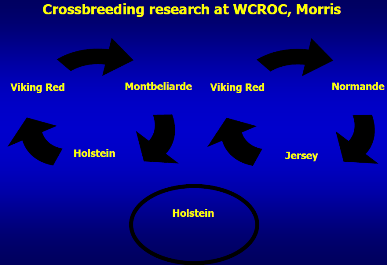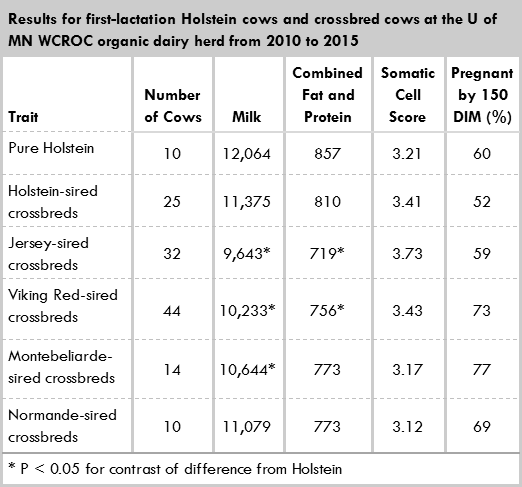By Brad Heins, Associate Professor, Dairy Science
March 2016
I receive a lot of questions about what breeds a farmer should use on an organic and grazing dairy farm. At the GrassWorks Grazing Conference in January, I moderated an industry panel on dairy breeds to consider for grass-based production. Therefore, I want to provide an update on the breeding plans and some preliminary results from the University of Minnesota organic dairy herd in Morris, MN.
First, we have recently completed and published a new report that provides results from first-lactation performance of 2-breed crossbreds compared to Holstein herdmates from 8 commercial confinement dairy herds in Minnesota. The 2-breed crossbreds had advantages in production, body condition score, fertility, and survival.
Whatever breeds are used in organic dairy herds, the ideal organic dairy cow must have: 1) high fat and protein, 2) excellent fertility and the ability to produce a calf regularly, 3) longevity (~5 to 7 years), 4) low somatic cell count, 5) smaller body size, and 6) efficient conversion of grass to milk. Of course, the use of a breed depends on each producer's management system.

At the organic dairy in Morris, we have developed two crossbreeding designs and are comparing them to Holstein herdmates. In one 3-breed rotation, we are using the Holstein, Montbéliarde, and Viking Red breeds (ProCROSS). The other 3-breed rotation uses the Viking Red, Jersey, and Normande breeds (no Holstein in the rotation). The accompanying figure provides the 3-breed rotation schemes for our dairy herd.
Subsequently, we decided to compare the organic cows sired by the alternative breeds at the University of Minnesota organic dairy for production and fertility. All cows were born after we started the transition to organic production during the fall of 2008. Data collection was from September 2010 to December 2015 and compared cows only during first lactation. The number of cows will only continue to grow as we continue these crossbreeding systems into the future. Therefore, the results are preliminary from our dairy herd (see accompanying table).

The Jersey-sired and Viking Red-sired crossbred cows had lower 305-day fat plus protein production compared to their Holstein herdmates during first lactation. The Viking Red crossbreds were lower for fat plus protein than other crossbred sired cows because the Viking Red cows were from dams that were 50% Jersey, and therefore, the Jersey influence may have caused the lower production, which was observed in the Jersey-sired crossbreds. The Montbéliarde and Normande-sired crossbred cows were similar to their Holstein herdmates for fat plus protein production during first lactation.
The table also has the percentage of cows pregnant by 150 days in milk during first lactation for crossbred cows versus Holsteins, and although not statistically significant, the Viking Red, Montbéliarde, and Normande-sired crossbred cows showed numerical advantage for fertility.
Recently, there has been interest in improving the robustness and profitability of grazing dairy cattle. In organic production systems failure of cows to become pregnant during the breeding season results in economic losses as maximum profit is attained by minimizing costs and increasing the proportion of grass in the diet of heifers and cows.
A few years ago, I presented an eOrganic webinar on breeding cattle for organic dairy productions systems. The webinar is very relevant today and describes more information related to crossbreeding for organic dairy herds. For more information, see the eOrganic webinar.
